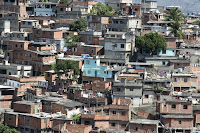This log-cabinesque quilt was conceived and executed so rapidly that it is hard for me to accurately track its development (not helped by leaving the work-in-progress images back in Australia while I am travelling) but here goes.
The roof graphic that accompanied Terri's announcement of the shelter theme reminded me of a tent. For me, camping has mostly happy associations with the great outdoors but I was mindful that for many people, tents are a necessity as they flee their homes due to war, famine and natural disasters. When I searched online for images of refugee camps for inspiration, I also found photos of shantytowns and suddenly I was back in sixth form geography class studying South America...
My home, my shelter, overlooks the beach of Copacabana. By contrast, the hills above the "other" Copacabana in Rio de Janeiro are densely crowded with irregular, improvisational shantytown structures known as "favela" providing shelter to a more than a quarter of Rio's citizens.
Favelas have their origins in the 19th century. When soldiers returned to Rio after quelling an insurrection, the government had yet to build housing it had promised in exchange for their services. In protest, the soldiers camped out on Rio's hills and nicknamed it “ favela ” after the favela plants that they encountered on their military campaign. Other favelas were formed by fugitive and freed slaves left with no place to live. With successive waves of rural people seeking work in the city and urban poor displaced from flood-prone areas, favelas have blossomed into self-made, strong and vibrant communities. Notes from the Hillside: The Funk and Favelas in Rio de Janeiro by Greg Scruggs offers fascinating insights into these communities as does this Washington Post article by Sean Green.
Rajah Award 2025
4 months ago






10 comments:
More log cabins!! I love it! This has an obvious energy to it and a bit of shabbiness too. On it's own it's enjoyable to look at, but with the description it takes on so much more depth. I also love that there's a connection between "your" Copacabana and Rio's.
I agree with Kristin. I love these little shabby log cabin blocks as a representation of a shanty town. The colors are perfect.
You completely captured the favela -- the colors, the wonkiness, the crampness.
Yes, the colours are perfect, the haphardness of the blocks, just everything. Great job, B!
Wow, Brenda. I love this. (But I was expecting another amazing shibori thing, thinking you were working on your own little series!)
This piece also has your name all over it -- your great graphics, use of color, repeating shapes...I love the visual rhythem. It illustrates the jumble of those hillside villages so well.
There are so many places in the world that look like this. It makes me think of the shanties of Quito and cities in Mexico. Gerrie saw similar sights in Israel and Palestine. It is such an appealing image and you have captured the spirit of these places wonderfully!
This piece is beautiful Brenda. I love the color palette. Looking at it on my screen I think it looks like this quilt might by about 40" x 40". I'm amazed you fit all those pieces into a 12" x 12" piece.
Oh, my first comment didn't make it this morning..
I love this quilt, Brenda.
Your colours are lovely. And the free log cabin is the perfect choice. A great piece.
Brenda, my husband saw this and flipped, he thought it was wonderful and I agree.. The grittiness and crowding comes thru perfectly, I think maybe the stripes might be why that works so well. Abstract at it's best
I agree. Fantastic. The wonky pieces is executed just perfectly. (At least it looks that way... I would LOVE to see it in person.) Though the photos help emphasize the subject, I think it comes through all on its own. Great job.
Post a Comment